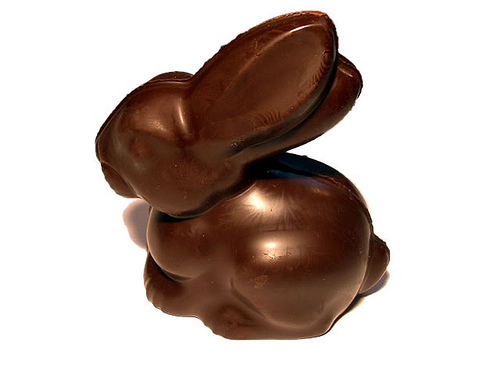
Green Your Easter
In case you haven’t noticed, the retail world has gone full force “Easter-Spectacular.” With Christmas over, it’s “out with the mince pies, in with the marshmallow hatchlings.” Every supermarket, drug store and big-box retailer is a psychedelic zoo of neon stuffed animals, disposable baskets and giant Styrofoam eggs.
So much of Easter has become commercialized, mass-produced, crapola–a far cry from Easter’s original ode to nature and rebirth. Yet, as most of us recognize the irony, few of us are willing to give up the childhood traditions of bunnies, candy and brightly colored cutesy things.
This Easter, consider a compromise. Trade in the dollar-store trinkets for “greener,” yet equally festive, alternatives. From re-purposed baskets to organic and fair-trade chocolates to natural egg dyes, there’s plenty of colorful flair that won’t harm the planet. Here are some tips:
The Basket:
Instead of wasting money and precious natural resources on Kmart’s taffeta “Lamb Candy Holder Basket”, hit up the local secondhand store or crafts fair for a “real” basket. Feeling particularly ambitious? Then make your own basket. You can learn the “art of basketry” here, or follow this simple pattern for newspaper, magazine cut-outs and wallpaper-swatch baskets. For true eco-ingenuity, or if you’re just really broke, get crafty with colorful tissue boxes, paper bags and your supermarket’s berry containers.
The Grass:
Now that you’ve got such a great basket, don’t ruin it with plastic grass. Just snip some from the top of your lawn. If you prefer foliage that won’t wilt or wither, flip through the pages of a magazine and cut out anything green. Shred it up and you’ve got grass-like filler.
The Eggs:
Most supermarket eggs come from notoriously filthy and inhumane commercial outfits, not old MacDonald’s farm. As the conditions of factory farms come to roost, many conscious consumers are demanding eggs that meet environmentally sound standards. You can demand the same by purchasing USDA organic eggs. For extra eco-brownie points, support your local farm. Find yours at localharvest.org.
The Homemade Eggs:
If you’re super eco-conscious and vegan, then you’re probably skipping the laid eggs altogether. Good for you, but don’t get tempted to the dollar-store’s jumbo plastic selection. Make your own “fake ones” with homemade paper-mache or cornstarch clay.
The Egg Dyes:
Skip the unholy mess of pellets and artificial food dyes. Fruits, vegetables and spices offer a wide range of color possibilities: from bright red to lavender, orange and blue. Just boil eggs (local and organic please) in water and a teaspoon of vinegar. Add ingredients below for desired color. Let simmer for at least 15 minutes. For a darker shade place the brew in the fridge for some overnight saturation.
Pink: beets, cranberries, frozen raspberries.
Red: red onionskins.
Orange: yellow onionskins.
Lavender: grape juice.
Light Yellow: orange or lemon peels, carrot tops, celery seed or ground cumin.
Yellow: Ground turmeric, saffron.
Pale Green: spinach leaves.
Blue: canned blueberries, red cabbage leaves.
Beige/Brown: strong brewed coffee.
Eggs dyed with onionskins, from Instructables.com
The Candy:
Peeps, lollipops, pecan nougat, jellybeans, and even Smucker’s Puckers are just a few Easter favorites. Aside from creating hyperactive chaos on Easter morning, Easter candies are grossly over-packaged. Yes, it is nice to get your egg in perfect condition, but does it really need to come swaddled in corrugated body armor? Look for the candies that come in the least amount of packaging. Cadbury Schweppes has the idea and is now offering eggs wrapped only in foil and without a cardboard box, cutting the company’s Easter packaging by 798,073 pounds.
The Chocolate:
As most of us know, chocolate comes from the cocoa bean, a crop harvested in some of the most economically and environmentally disadvantaged parts of the third world. According to reports from the BBC and New York Times, cocoa producing regions are rife with environmental and humanitarian iniquity.
This Easter, why give your children chocolate made from the sweat and sometimes even blood of less fortunate children? Swap the waxy dollar-store chocolate for organic and fair trade alternatives. Fair trade certification ensures chocolate is made under both environmental and humanitarian standards. According to the Fair Trade Organization (FTO), these standards are quite stringent, ensuring the minimum use and safe handling of agrochemicals, conservation of water, controls on gathering from the wild and deforestation, a ban on GMO (Genetically Modified Organism). For a list of delicious organic and fair trade chocolate options click here.
The Bunnies: Live or Stuffed?
According to the House Rabbit Society, a national, nonprofit bunny welfare organization, each spring, unwanted “former Easter rabbits” fill local rescues, humane societies and worse dumpsters. Unless you’re in it for the long haul and know how to take care of one, please, don’t put a live bunny in your Easter basket! Leave little Peter Cottontail be . . . to hop down the old bunny trail . . . hippity hoppity, Easter’s on its way.
Happy Easter! Please leave your greener Easter suggestions in the comments section.
For more posts like this from Olivia Zaleski check out her weekly column on the Huffington Post





